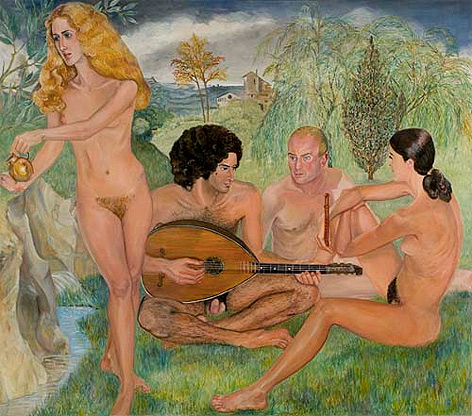Sylvia Sleigh, artist
Realist painter Sylvia Sleigh (1916-2010) was awarded a Lifetime Achievement Award by Women’s Caucus for Art shortly before her death in 2010. Celebrated for her portraiture and male nudes, she “turned traditional portraiture on its head by presenting the male nude posed as a reclining Venus or odalisque.” The Times, Oct 2010.

Sylvia Sleigh, The Turkish Bath
Born in 1916, Sylvia Sleigh grew up in Hove and was a student at the Brighton School of Art. When she died in New York in 2010, she had been honoured with the announcement of a Lifetime Achievement Award, 2011 by Women’s Caucus for Art and had received the 2008 Distinguished Artist Award for Lifetime Achievement by the College Art Association.
Her most celebrated work began to emerge around 1970 when, motivated by feminist art principles, she produced a series of paintings which featured male nudes alluding directly to canonical female nudes, for example those of Ingres, Titian and Velázquez.
Asked in 2007, “How has feminism changed contemporary art practice?” Sylvia Sleigh responded:
“I feel that my paintings stress the equality of men & women (women & men).
“To me, women were often portrayed as sex objects in humiliating poses. I wanted to give my perspective. I liked to portray both man and woman as intelligent and thoughtful people with dignity and humanism that emphasized love and joy.

Sylvia Sleigh, Paul Rosano in Jacobson Chair 1971
“I did this by placing my models in beautiful settings outside or inside against colorful landscapes or pleasing fabrics. To me, it made me think that the model was a jewel, being emphasized by their surrounding or environment. Feminism allowed me to express my thoughts freely. It gave me the freedom to show the beauty of the body – the most luminous parts equally. My style is the way I can best express these ideas.
“Feminism gave us this intense freedom of expression thus allowing a change. Anything that helps to express the artist’s ideas, whether it is to surprise, glorify, shock or simply express a philosophy will lead to a change or will simply allow an opportunity for change.”
After studying at the Brighton School of Art, Sylvia Sleigh worked as a dresser at a women’s clothing store on Bond Street, London, before opening her own shop in Brighton, making hats, coats and dresses. The shop closed in 1939 and Sylvia married the artist Michael Greenwood in 1941 before moving to London and starting to paint again. In 1953 she had her first solo show, at the Kensington Art Gallery, London, featuring still-lifes, landscapes and portraits, in oil and watercolour, painted since 1949.
She remarried in the early 1950s, to Lawrence Alloway, the well-known art critic and one of the most important members of the influential Independent Group. The couple moved to the United States of America in the early 1960s, where Lawrence worked as curator at the Solomon R Guggenheim Museum. Through her work with the Ad Hoc Committee of Women Artists and Women in the Arts, as well as her exhibitions with the SoHo 20 Gallery and A.I.R., her reputation as a feminist artist grew.
For the Brooklyn Museum in 1995, Sylvia commented:
“It has always been difficult for women to do creative work or indeed to have any profession that endows prestige in our chauvinist patriarchal society. It was particularly hard for ambitious women painters who wished to paint the most highly regarded subjects—history pictures. This was because it was impossible for them to do drawings and paintings from nude models, female or male, so that figure compositions would be most difficult for them. Once I became aware of this situation in the ‘60s, I made a point of finding male models and I painted them as portraits, not as sex objects, but sympathetically as intelligent and admired people, not as women had so often been depicted as unindividuated houris. I had noted from my childhood that there were always pictures of beautiful women but very few pictures of handsome men so I thought that it would be truly fair to paint handsome men for women.”
Sources:
http://www.nytimes.com/2010/10/26/arts/design/26sleigh.html?_r=1
https://www.brooklynmuseum.org/eascfa/feminist_art_base/gallery/sylviasleigh.php
Image ‘The Turkish Bath’ reproduced with kind permission of the Smart Museum, University of Chicago.
Images ‘Concert Champêtre’ and ‘Paul Rosano in Jacobson Chair 1971’ with kind permission of I-20 Gallery, New York.
